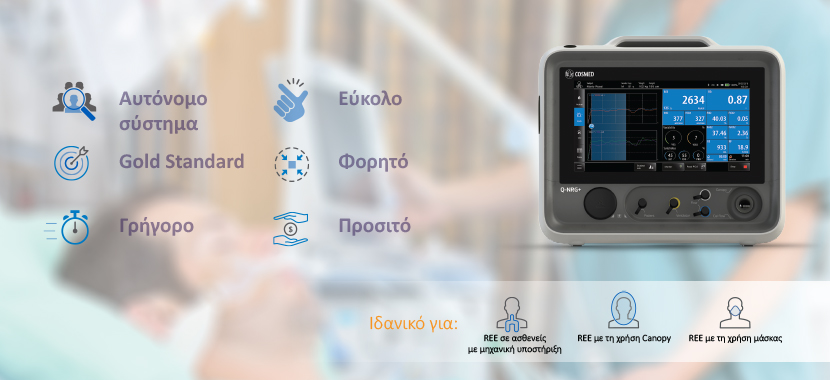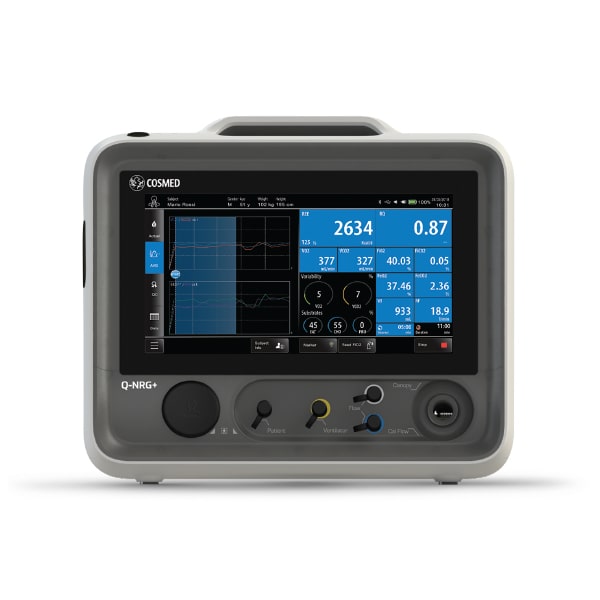

Introducing the new generation of Metabolic Monitors for Indirect Calorimetry in Clinical and Critical Care Practice
"In critically ill mechanically ventilated patients, EE should be determined by using indirect calorimetry"
ESPEN guidelines on clinical nutrition in the intensive care unit. Singer P, et al. Clinical Nutrition. 2018
Introduced by COSMED, worldwide leader in the design of metabolic systems for clinical and human performance applications, Q-NRG is the first Indirect Calorimeter specifically intended for the measurement of Resting Energy Expenditure (REE) in patients who are mechanically ventilated or spontaneously breathing and for healthy subjects.
Indirect calorimetry remains the Gold Standard in measuring energy expenditure in clinical settings, proven to have enormous advantages compared to Predictive Equations1. In fact, this measuring technology provides an individual and dynamic metabolic assessment based on the actual physical status of the subject rather than estimating it on anthropometric data.
Q-NRG is a unique product, the result of COSMED’s collaboration with world-class institutes in the field of nutrition support in intensive care units. Product concept and specifications have been designed together with the ICALIC Trial study group2. This collaboration made possible the development of an accurate metabolic system simple to use and at the same time able to solve all typical pitfalls of Indirect Calorimetry technology.
Q-NRG options - Vent, Canopy, Mask
Individual Metabolic Assessment Q-NRG uses the Gold Standard Indirect Calorimetry technique to measure metabolic parameters. The technique itself guarantees that the results reflect the metabolic alterations during illness and repeated measurements may correspond with disease progression or resolution4. QNRG is the ultimate tool to develop individual nutrition support plans and optimize them to prevent over/underfeeding, to reduce length of stay and, ultimately, to decrease costs in ICU.
Indirect Calorimetry, a Gold Standard Q-NRG is the result of more than 30 years of experience in the design of metabolic systems. The new calorimeter has been validated in-vitro by international multicentre study showing the greatest accuracy with excellent agreement vs. mass spectrometer measurements5,6.
Quick to operate, clean and maintain Q-NRG has been designed to reduce operations and measurement time. System does not require warm-up time nor user-assisted calibrations, all operations can be performed with a few taps on the screen and cleaning procedures are simplified thanks to rounded surfaces and single-use accessories.
Designed for Clinical Practice Q-NRG usability has been designed according to best clinical practice. An intuitive workflow supports the user through all operations with main instructions prompted along the procedures and test information always accessible. Designed to be portable, the device can be easily transported between rooms.
Latest Technologies in a Compact Device Q-NRG is a compact, lightweight, battery operating device. The 10” inches LCD touchscreen simplify access to all operations. Bluetooth, USB, RS-232 and LAN interfaces allow to connect the system to any hub (PC, printers, etc.).
Affordable Q-NRG has been designed to compete with conventional metabolic system, at a fraction of the cost.
One tool for many applications. Q-NRG provides all the flexibility for a variety of clinical settings, assessing different patient's conditions (mechanically ventilated or spontaneously breathing) and with different techniques (Canopy Hood and/or face masks), from adults to pediatric starting from 10 kg.
Standalone or PC based user mode. Q-NRG can be operated either via the integrated LCD touchscreen or controlled from a computer via OMNIA PC software (optional), with data transfer done wireless through Bluetooth® or USB interfaces.
